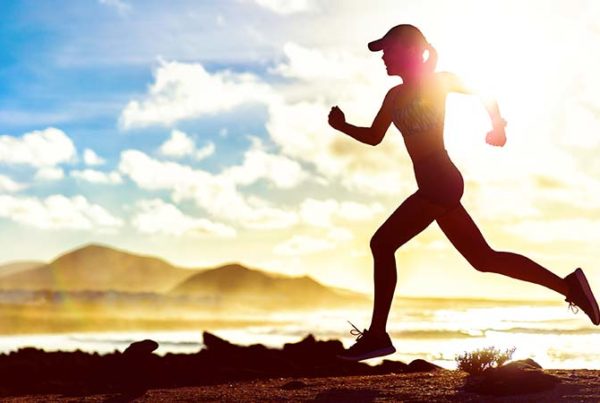Barefoot running is impractical in the desert mountains of southern Arizona because of all the wind-blown thorns that can puncture the bottom of the foot; but barefoot running shoes, like the VFF Bikila, makes this entirely practical– and with surprising results.
By Coralee Thompson, M.D.
I’ve been working out for much of my adult life, and since first meeting Dr.Phil Maffetone in 1997, running always included wearing very flat shoes. The past few years while living in the mountains of southern Arizona, we sometimes combine three activities that might include hiking, running, walking, biking and swimming. In addition, moving heavy mounds of soil for the garden, lifting large rocks, and other chores more than satisfies the anaerobic aspects of the neuromuscular system.
Recently, I noticed my cheap $20 running shoes, about four or five years old, were ready for retirement. They served me well. Phil helped me find a good stride and cadence, and maintain a good posture while running. But even though I’m 10 years younger than him, my heart rate was always 10 beats higher.
We often discuss barefoot biomechanics, not to mention many other aspects of health and fitness—we live it. Luckily, if anything ever goes wrong with my muscles or joints, he’s quick to fix it. But I miss not being barefoot outdoors more. The Arizona desert, with its wind-blown thorns everywhere, especially on the seemingly smooth trails and dirt roads, is not the place to be barefoot, especially for running of any significant duration even though we’re that way much of the day inside and right around the outdoors.
The other day I went into Tucson for gardening supplies, and succumbed to my intrigue of owning Vibram FiveFingers. It was not impulsive, but it was just time. Before doling out $100-plus for a cute light grey and green pair called Bikila and in a size 42 men’s, I made sure that Summit Hut sports store offered a return policy. It did.
Phil and I talked about the potential issue of having to get used to this type of footwear. “Your muscles are very well balanced, and your feet quite healthy, so in your case, making the change should not be difficult or require a period of breaking them in,” Phil told me.
Apparently, a lot of runners are having trouble making the transition. We’ve read and heard about runners having to wean into using these glove-like shoes, sometimes taking weeks to get used to them or not able to run in them without causing blisters or pain.
Just to be sure, I wore them when I left the store and kept them on until I got home—making about a dozen quick stops at various stores along the way. So far they felt great.
Yesterday, during our morning run, I wore them. They felt even better. In fact, I felt like a great runner—like those photos of lead-pack marathoners. Well, almost.
Phil did say my gait, stride and cadence were even better than usual, and the time my foot stayed on the ground appeared to be much less. I was running with grace and ease that I have never felt in my life in all the years I’ve run.
Phil also noticed that my improved mechanics seemed like it would reduce the cost of running. Daniel Lieberman, Ph.D., was recently quoted in Harvard Magazine that running barefoot is about five percent more efficient than wearing shoes. But that’s an estimate, and he’s not taking into account people whose feet fall apart when they take off their shoes. Since their feet are full of distortions, due to daily trauma, such as bone injuries often disguised as a “normal” ache or pain, muscle dysfunction, and toe damage that creates an adequate enough nervous system injury that the whole body will twist, bend, warp and otherwise need much more energy to do the same work. Likewise, a person with near perfect feet would take their shoes off to run and feel, well, aaaahh—balance, comfort, freedom, and the need for less energy. That’s the difference.
I had never felt that elusive “spring back” affect that kinesiologists often talk about—I even read about it in Phil’s recent article on video gait analysis. But there it was, a sensory sensation, with every step I took.
We also hear and read about people who buy the Vibrams, then run too fast, or too far, and develop pain. Some even keep running after the pain comes on—this is the ultimate no pain no gain blooper. Others develop bone fractures in the toes, apparently not an uncommon complaint. Now it’s quite obvious—it’s not the shoes, it’s the feet!
But all this really didn’t hit me until half way through our short 40-minute trail run—my heart rate was about 10 beats lower than usual. This was evident because I felt myself going faster—much faster.
I thought Phil was behind me all that time to analyze my gait, but now it was evident that, not only did I make up the difference of 10 beats between Phil’s heart rate and mine, it was lower by a couple more beats. I need to get him a pair of these (well, even if it makes him run faster).
All these new albeit relatively minimal but noticeable changes in my gait translated to almost a minute a mile faster at the same heart rate! We also run by time, not sure of the exact distance, and don’t have mile splits so this was not a scientific study.
But today we ran again—same course, same time of day, same result. I love running fast! The human body never ceases to amaze me.








